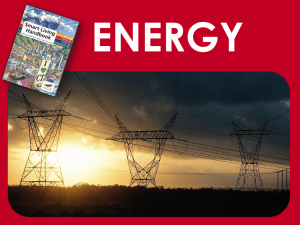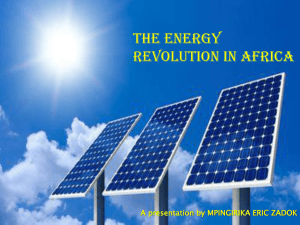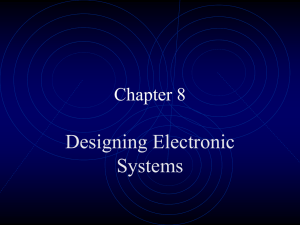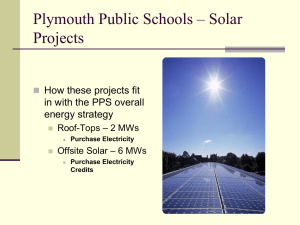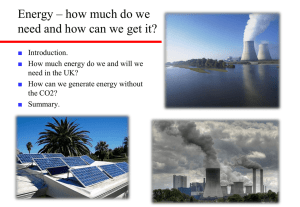Economics of solar PV in the United States
advertisement
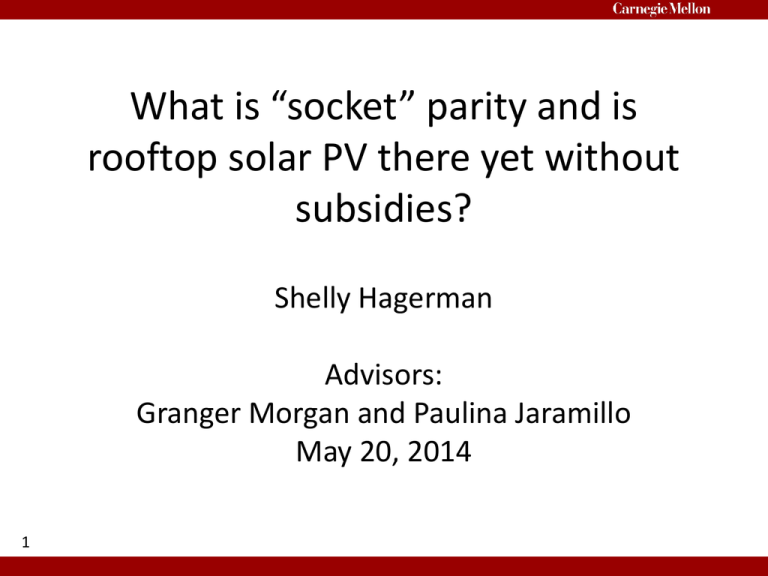
What is “socket” parity and is rooftop solar PV there yet without subsidies? Shelly Hagerman Advisors: Granger Morgan and Paulina Jaramillo May 20, 2014 1 Background • Growing need for renewables – Focus on wind and solar • Federally subsidized by the Investment Tax Credit (ITC) – 30% of upfront capital costs – Set to expire at end of December 2016 • State and local subsidies – Tax incentives, rebates, loans, etc. 2 Research Questions • Is residential solar at “socket” parity? – Technology breaks even when paid retail electricity price. • If not, how to get there? – Cost reductions 3 How to assess socket parity? Method Scope Shortcomings Literature Levelized cost of electricity (LCOE) Capital cost, capital recovery factor, average capacity factor Omits electricity prices (revenues). Time value of money not explicit Fairley 2013, Darling et al. 2009 Payback period Capital cost, average annual production, average electricity price Average values for the entire project lifetime. Does not account for time value of money Hay 2013, Richter 2009 Net present value (NPV) Capital cost, More complex annual production, than LCOE or electricity prices, payback period financing details, discount rates 4 Hay 2013, Richter 2009, Banoni et al. 2012 Calculating the NPV Capital Cost (Installation Cost) Residential Electricity Price Solar Insolation 5 Required Inputs Financing (rate, term) Discount Rate (DR) Module Characteristics System Size (4 kW) Operation and Maintenance Parameters Output Electricity Price Escalation Rate (ER) Net Present Value (NPV) Parameters Used • Retail Price of Electricity – State average residential prices [EIA] • Escalation Rate of Electricity Prices (2-5%) • Discount Rate (7%) • System Details – 4 kW, 25 year lifetime, 0.5% degradation rate after initial 3% loss in first year1 • Financing – 15-25 years, 5-8% interest rate 1 6 S. Roe, “Solar Efficiency Losses Over Time.” Installation Costs ($/W) Region 7 20th Percentile Median Northeast 4.3 5.1 Mid-Atlantic 4.4 4.7 Southeast 4.6 5.6 Midwest 4.6 5.8 Southwest 3.9 4.6 Northwest 4.5 5.1 Texas 3.5 3.9 California 4.8 5.7 Hawaii* 4.6 5.6 Alaska* 4.6 5.6 Values based on NREL PV Pricing Trends 2013 * Information not available. Applied average range for 2-5kW systems. Residential Electricity Price (Sept 2013 State Averages) 8 Based on EIA Electric Power Monthly Energy Produced by System • Using Sandia PV Performance Model – Sun-Earth geometry – Solar insolation – Module performance characteristics • U.S. weather data from 1011 stations – Typical meteorological year (TMY) – Locations across all 50 states 9 Energy Produced by 4 kW System 10 Scenarios for Evaluating NPV Variable Pessimistic Estimate Best Estimate Optimistic Estimate Median Values 20th Percentile 20th Percentile Loan Interest Rate 8% 7% 5% Loan Term (years) 15 20 25 Electricity Price Escalation Rate 2% 3% 5% Installation Cost ($/W) 11 NPV Pessimistic Estimate Features: Median installation costs Electricity Price ER = 2% Loan Interest Rate = 8% Loan Term = 15 years 12 NPV Best Estimate Features: 20th Percentile installation costs Electricity Price ER = 3% Loan Interest Rate = 7% Loan Term = 20 years 13 NPV Optimistic Estimate Features: 20th Percentile installation costs Electricity Price ER = 5% Loan Interest Rate = 5% Loan Term = 25 years 14 Socket Parity Summary 15 Scenario Number of states at socket parity Pessimistic Estimate 0 Best Estimate 1 (Hawaii) Optimistic Estimate 1 (Hawaii) Break-even Analysis Pessimistic Estimate Optimistic Estimate Best Estimate 16 Sensitivity Analysis Variable Median 80% of 20th Percentile Loan Interest Rate 8% 0% Loan Term (years) 5 30 Electricity Price Escalation Rate 2% 7% Discount Rate 0% 10% Wholesale 2013 Retail Installation Cost ($/W) Starting Electricity Price 17 Pessimistic Limit Optimistic Limit Conclusions • These results suggest that residential solar PV is still not at “socket” parity in most of the U.S. • Mean break-even cost of $1.5-$2/W for “socket” parity without subsidies 18 Future Work • Cost of variability – Regional variation of cost to grid and technology performance – Use of empirical data to evaluate solar output aggregation effects • Optimizing subsidy allocation 19 Acknowledgements • ClIMA Research Group • This work was supported by academic funds from the Department of Engineering and Public Policy, by the program for Graduate Assistance in Areas of National Need (GAANN) of the U.S. Department of Education, by the Department of Energy under Awards DE-OE0000300 and DEOE0000204, and by the NSF center for Climate and Energy Decision Making Center (CEDM) (SES0949710). 20


